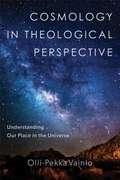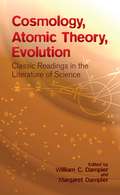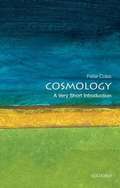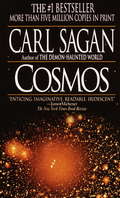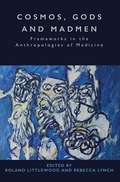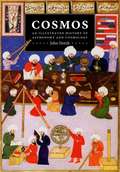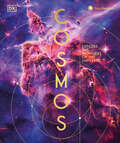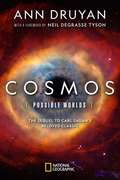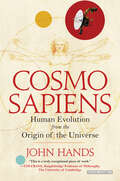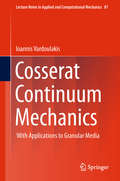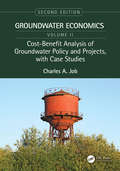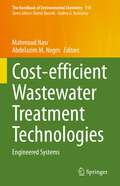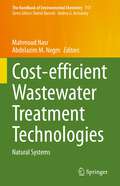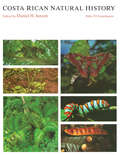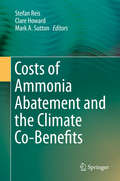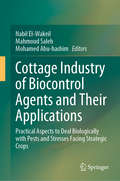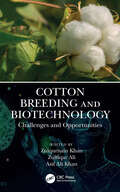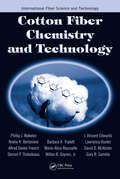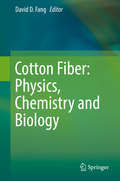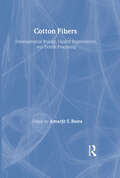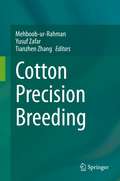- Table View
- List View
Cosmology in Theological Perspective: Understanding Our Place in the Universe
by Olli-Pekka VainioOlli-Pekka Vainio, a leading expert in science and theology, explores questions concerning the place and significance of humans in the cosmos. Vainio introduces cosmology from a "state of the question" perspective, examining the history of the idea in dialogue with C. S. Lewis. This work, which is related to a NASA-funded project on astrobiology, ties into the ongoing debate on the relationship between Christian theism and scientific worldview and shows what the stakes are for religion and theology in the rise of modern science.
Cosmology in the Early Modern Age: A Web of Ideas (Logic, Epistemology, and the Unity of Science #56)
by Paolo Bussotti Brunello LottiThis volume addresses the history and epistemology of early modern cosmology. The authors reconstruct the development of cosmological ideas in the age of ‘scientific revolution’ from Copernicus to Leibniz, taking into account the growth of a unified celestial-and-terrestrial mechanics. The volume investigates how, in the rise of the new science, cosmology displayed deep and multifaceted interrelations between scientific notions (stemming from mechanics, mathematics, geometry, astronomy) and philosophical concepts. These were employed to frame a general picture of the universe, as well as to criticize and interpret scientific notions and observational data.This interdisciplinary work reconstructs a conceptual web pervaded by various intellectual attitudes and drives. It presents an historical–epistemological unified itinerary which includes Copernicus, Kepler, Galileo, Descartes, Huygens, Newton and Leibniz. For each of the scientists and philosophers, a presentation and commentary is made of their cosmological views, and where relevant, outlines of their most relevant physical concepts are given. Furthermore, the authors highlight the philosophical and epistemological implications of their scientific works. This work is helpful both as a synthetic overview of early modern cosmology, and an analytical exposition of the elements that were intertwined in early-modern cosmology. This book addresses historians, philosophers, and scientists and can also be used as a research source book by post-graduate students in epistemology, history of science and history of philosophy.
Cosmology, Atomic Theory, Evolution: Classic Readings in the Literature of Science (General Science)
by William Dampier Margaret DampierFrom the biblical book of Genesis to Henri Bergson's Creative Evolution, these extracts from world literature illustrate the development of scientific thought across millennia. Starting with speculations by the ancient Greeks on the structure of the universe, selections on cosmogony include works by Copernicus, Galileo, Newton, Laplace, Foucault, and Einstein. Theories and reports on experimental results concerning the nature of matter range from Paracelsus' writings on alchemy to Faraday's work with electrochemistry and Sir Ernest Rutherford's studies of radioactivity and the structure of the atom. The final section on evolutionary theory begins with Aristotle and Pliny and features landmark works by the giants in the field, among them, Linnaeus, Lamarck, Lyell, Malthus, Darwin, and Mendel. 36 figures. 7 tables.
Cosmology: A Very Short Introduction
by Peter ColesWritten in simple and accessible language, this non-technical introduction to cosmology, or the creation and development of the universe, explains the discipline, covers its history, details the latest developments, and explains what is known, what is believed, and what is purely speculative. In addition, the author discusses the development of the Big Bang theory, and more speculative modern issues like quantum cosmology, superstrings, and dark matter.
Cosmos
by Carl SaganThis visually stunning book with over 250 full-color illustrations, many of them never before published, is based on Carl Sagan's thirteen-part television series. <P><P>Told with Sagan's remarkable ability to make scientific ideas both comprehensible and exciting, Cosmos is about science in its broadest human context, how science and civilization grew up together. <P><P>The book also explores spacecraft missions of discovery of the nearby planets, the research in the Library of ancient Alexandria, the human brain, Egyptian hieroglyphics, the origin of life, the death of the Sun, the evolution of galaxies and the origins of matter, suns and worlds. <P><P>Sagan retraces the fifteen billion years of cos-mic evolution that have transformed matter into life and consciousness, enabling the Cosmos to wonder about itself. He considers the latest findings on life elsewhere and how we might communicate with the beings of other worlds. <P><P>Cosmos is the story of our long journey of discovery and the forces and individuals who helped to shape modern science, including Democritus, Hypatia, Kepler, Newton, Huygens, Champollion, Lowell and Humason. <P><P> Sagan looks at our planet from an extra-terrestrial vantage point and sees a blue jewel-like world, inhabited by a lifeform that is just beginning to discover its own unity and to ven-ture into the vast ocean of space.
Cosmos, Gods and Madmen: Frameworks in the Anthropologies of Medicine
by Lynch LittlewoodThe social anthropology of sickness and health has always been concerned with religious cosmologies: how societies make sense of such issues as prediction and control of misfortune and fate; the malevolence of others; the benevolence (or otherwise) of the mystical world; local understanding and explanations of the natural and ultra-human worlds. This volume presents differing categorizations and conflicts that occur as people seek to make sense of suffering and their experiences. Cosmologies, whether incorporating the divine or as purely secular, lead us to interpret human action and the human constitution, its ills and its healing and, in particular, ways which determine and limit our very possibilities.
Cosmos: An Illustrated History of Astronomy and Cosmology
by John D. NorthFor millennia humans have studied the skies to help them grow crops, navigate the seas, and earn favor from their gods. We still look to the stars today for answers to fundamental questions: How did the universe begin? Will it end, and if so, how? What is our place within it? John North has been examining such questions for decades. In Cosmos, he offers a sweeping historical survey of the two sciences that help define our place in the universe: astronomy and cosmology. Organizing his history chronologically, North begins by examining Paleolithic cave drawings that clearly chart the phases of the moon. He then investigates scientific practices in the early civilizations of Egypt, Greece, China, and the Americas (among others), whose inhabitants developed sophisticated methods to record the movements of the planets and stars. Trade routes and religious movements, North notes, brought these ancient styles of scientific thinking to the attention of later astronomers, whose own theories-- such as Copernicus' planetary theory-- led to the Scientific Revolution. The work of master astronomers, including Ptolemy, Galileo, Kepler, and Newton, is described in detail, as are modern-day developments in astrophysics, such as the advent of radio astronomy, the brilliant innovations of Einstein, and the many recent discoveries brought about with the help of the Hubble telescope. This new edition brings North's seminal book right up to the present day, as North takes a closer look at last year's reclassification of Pluto as a "dwarf" planet and gives a thorough overview of current research. With more than two hundred illustrations and a comprehensive bibliography, Cosmos is the definitive history of astronomy and cosmology. It is sure to find an eager audience among historians of science and astronomers alike.
Cosmos: Explore the Wonders of the Universe (DK Secret World Encyclopedias)
by DKAstonishing images bring every corner of the universe, from Mars to the farthest galaxies, to the printed page.Cosmos is a visually captivating journey through the universe and is as expansive as the cosmos itself. It covers everything from the asteroid belt to deep space probes, the ISS to the Oort Cloud, the Big Bang to the end of the universe, and (just about) everything in between. It presents space as humanity has never seen it before, featuring the latest images from NASA’s James Webb Space Telescope, and a wealth of new pictures that also includes panoramic views of the surface of Mars and images captured by probes that have landed for the first time on comets and asteroids.Cosmos is a tour through space, starting with the sun and inner solar system then moving through the outer planets and into the Milky Way and finally the realm of distant galaxies. The gorgeous images are supported by illustrations that dissect the image or explain the processes going on, such as star birth or the workings of supermassive black holes. Throughout the book are features on the technology of space exploration, the history of astronomy, and our cultural connection to the night sky. With a clear, stylish, pared-back design, Cosmos is a perfect introduction to the wonders of the universe for young and old astronomers alike. Make time for space time!
Cosmos: Possible Worlds
by Ann DruyanThis sequel to Carl Sagan's blockbuster continues the electrifying journey through space and time, connecting with worlds billions of miles away and envisioning a future of science tempered with wisdom.Based on National Geographic's internationally-renowned television series, this groundbreaking and visually stunning book explores how science and civilization grew up together. From the emergence of life at deep-sea vents to solar-powered starships sailing through the galaxy, from the Big Bang to the intricacies of intelligence in many life forms, acclaimed author Ann Druyan documents where humanity has been and where it is going, using her unique gift of bringing complex scientific concepts to life. With evocative photographs and vivid illustrations, she recounts momentous discoveries, from the Voyager missions in which she and her husband, Carl Sagan, participated to Cassini-Huygens's recent insights into Saturn's moons. This breathtaking sequel to Sagan's masterpiece explains how we humans can glean a new understanding of consciousness here on Earth and out in the cosmos--again reminding us that our planet is a pale blue dot in an immense universe of possibility.
Cosmosapiens: Human Evolution from the Origin of the Universe
by John Hands&“A critical overview of scientific orthodoxy in an attempt to answer the fundamental questions &“what are we?&” and &“why are we here?&” (Kirkus Reviews). Specialist scientific fields are developing at incredibly swift speeds, but what can they really tell us about how the universe began and how we as humans evolved to play such a dominant role on Earth? John Hands&’s extraordinarily ambitious book merges scientific knowledge from multiple disciplines and evaluates without bias or preconception all the theories and evidence about the origin and evolution of matter, consciousness, and mankind. The result, a &“pearl of dialectical reasoning&” (Publishers Weekly, starred review), provides the most comprehensive account yet of current ideas such as cosmic inflation, dark energy, the selfish gene, and neurogenetic determinism. In the clearest possible prose, it differentiates the firmly established from the speculative and examines the claims of various fields to approach a unified theory of everything. In doing so it challenges the orthodox consensus in those branches of cosmology, biology, and neuroscience that have ossified into dogma. Its &“shocking and invigorating&” analysis (Daily Telegraph, A Best Science Book of 2015) reveals underlying patterns of cooperation, complexification, and convergence that lead to the unique emergence in humans of a self-reflective consciousness that enables us to determine our future evolution. This groundbreaking book is destined to become a classic of scientific thinking.Praise for Cosmosapiens &“This is a truly exceptional piece of work.&” —Tim Crane, Knightsbridge Professor of Philosophy, The University of Cambridge &“A game-changer. In the tradition of Thomas Kuhn&’s The Structure of Scientific Revolutions, this lucidly written, penetrating analysis challenges us to rethink many things we take for granted about ourselves, our society, and our universe. It will become a classic.&” —Peter Dreier, E P Clapp Distinguished Professor of Politics, Occidental College &“Hands is an astute observer of recent trends in scientific ideas bold enough to point out what he sees as sense and nonsense and intelligently explain why. Even in cases where one might disagree, the arguments are thought-provoking.&” —Paul Steinhardt, Albert Einstein Professor in Science, Princeton University
Cosserat Continuum Mechanics: With Applications To Granular Media (Lecture Notes in Applied and Computational Mechanics #87)
by Ioannis VardoulakisThis textbook explores the theory of Cosserat continuum mechanics, and covers fundamental tools, general laws and major models, as well as applications to the mechanics of granular media. While classical continuum mechanics is based on the axiom that the stress tensor is symmetric, theories such as that expressed in the seminal work of the brothers Eugène and François Cosserat are characterized by a non-symmetric stress tensor. The use of von Mises motor mechanics is introduced, for the compact mathematical description of the mechanics and statics of Cosserat continua, as the Cosserat continuum is a manifold of oriented “rigid particles” with 3 dofs of displacement and 3 dofs of rotation, rather than a manifold of points with 3 dofs of displacement. Here, the analysis is restricted to infinitesimal particle displacements and rotations. This book is intended as a valuable supplement to standard Continuum Mechanics courses, and graduate students as well as researchers in mechanics and applied mathematics will benefit from its self-contained text, which is enriched by numerous examples and exercises.
Cost-Benefit Analysis of Groundwater Policy and Projects, with Case Studies: Groundwater Economics, Volume 2
by Charles A. JobThe competition for groundwater sources as a water supply reinforces the need for a strong economic rationale in decision-making. Evaluating economic decisions in the context of total water management and life-cycle water use is essential to making critical development and remediation choices. This revised volume provides fundamental economic and policy concepts related to groundwater, discusses important factors in life-cycle cost-benefit evaluation and explains triple-bottom-line analysis for different groundwater projects. It includes new and updated case studies on groundwater issues with solutions for a range of situations based on economic data. FEATURES OF THIS VOLUME Provides an understanding for the fundamental economic approaches to groundwater policy and project evaluation Incorporates life-cycle cost-benefit approaches in a triple-bottom-line framework Includes new case studies on the economics of health protection, managed aquifer recharge, local versus regional supply and strategic life-cycle analysis Addresses local and regional groundwater economic choices through a series of practical applications Explores transboundary, international, climate change and macroeconomic factors influencing groundwater project and program decisions Cost-Benefit Analysis of Groundwater Policy and Projects, with Case Studies, Second Edition, the second volume of the two-volume set Groundwater Economics, is a must-have for any professional or student who needs to understand and evaluate water resources and manage their use from a variety of sustainable approaches.
Cost-efficient Wastewater Treatment Technologies: Engineered Systems (The Handbook of Environmental Chemistry #118)
by Abdelazim M. Negm Mahmoud NasrThis is the second of two volumes that together provide a comprehensive overview of the current sustainable and low-cost wastewater treatment technologies applied in communities that lack the financial and technical resources needed for an environmental, disease prevention and health nexus. This book reviews engineered wastewater treatment technologies and discusses their application in regard to greenhouse gas emissions, natural resource utilization, land-use, and energy and water savings. The chapters from expert contributors cover topics such as aerobic and anaerobic biological treatments, chemical treatments and precipitation, and disinfection. Readers will also learn about simplified and low-energy wastewater treatment plants, strategies for wastewater reuse, and nanotechnologies for wastewater environmental management. The feasibility regarding time and cost of implementing such technologies is also discussed in this book, and particular attention is given to the removal of conventional and emerging pollutants, toxicants, and heavy metals. Given the breadth and depth of its coverage, the book offers an invaluable source of information for researchers, students and environmental managers alike.
Cost-efficient Wastewater Treatment Technologies: Natural Systems (The Handbook of Environmental Chemistry #117)
by Abdelazim M. Negm Mahmoud NasrThis is the first of two volumes that together provide a comprehensive overview of the current sustainable and low-cost wastewater treatment technologies applied in communities that lack the financial and technical resources needed for an environmental, disease prevention and health nexus.This book reviews natural wastewater treatment technologies and traces the current challenges in wastewater management and sustainability. Divided into 4 themed parts, the chapters from expert contributors cover topics such as simplified and low-energy natural treatment facilities, bioremediation and biotechnology for green future, environmental impact assessment of wastewater reuse, wastewater management and sustainability for irrigation, high-performance and cost-effective biosorbents for heavy metals removal, and eco-friendly nanomaterials for wastewater environmental management. The readers will discover essential recommendations for improving natural treatment systems to withstand emerging contaminants, namely, endocrine disruption chemicals, surfactants, personal care products, pesticides, and pharmaceuticals. Readers will also find valuable guidelines to ensure sustainable and innovative solutions for wastewater treatment in the light of climate change, resource, demand, and funding challenges.Given the breadth and depth of its coverage, the book offers an invaluable source of information for researchers, students and environmental managers alike.
Costa Rican Ecosystems
by Maarten KappelleIn the more than thirty years since the publication of Daniel H. Janzen’s classic Costa Rican Natural History, research in this small but astonishingly biodiverse, well-preserved, and well-studied Latin American nation has evolved from a species-level approach to the study of entire ecosystems. And from the lowland dry forests of Guanacaste to the montane cloud forests of Monteverde, from the seasonal forests of the Central Valley to the coastal species assemblages of Tortuguero, Costa Rica has proven to be as richly diverse in ecosystems as it is in species. In Costa Rican Ecosystems, Maarten Kappelle brings together a collection of the world’s foremost experts on Costa Rican ecology—outstanding scientists such as Daniel H. Janzen, Jorge Cortés, Jorge A. Jiménez, Sally P. Horn, Robert O. Lawton, Quírico Jiménez M., Carlos Manuel Rodríguez, Catherine M. Pringle, and Eduardo Carrillo J., among others—to offer the first comprehensive account of the diversity, structure, function, uses, and conservation of Costa Rica’s ecosystems. Featuring a foreword and introductory remarks by two renowned leaders in biodiversity science and ecological conservation, Thomas E. Lovejoy and Rodrigo Gámez Lobo, in addition to chapters highlighting the geology, soils, and climate of Costa Rica, as well as the ecosystems of its terrestrial, freshwater, and marine habitats, and including previously unpublished information on Isla del Coco, this beautiful color-illustrated book will be an essential reference for academic scientists, students, natural history guides, conservationists, educators, park guards, and visitors alike.
Costa Rican Natural History: With 174 Contributors
by Daniel H. JanzenThis volume is a synthesis of existing knowledge about the flora and fauna of Costa Rica. The major portion of the book consists of detailed accounts of agricultural species, vegetation, amphibians, reptiles, mammals, birds, and insects. "This is an extraordinary, virtually unique work. . . . The tremendous amount of original, previously unpublished, firsthand information is remarkable."—Peter H. Raven, Director, Missouri Botanical Garden "An essential resource for anyone interested in tropical biology. . . . It can be used both as an encyclopedia—a source of facts on specific organisms—and as a source of ideas and generalizations about tropical ecology."—Alan P. Smith, Ecology
Costs And Returns For Agricultural Commodities: Advances In Concepts And Measurement
by Mary AhearnPolicymakers, farmers, managers of agriculture and others look to agricultural economists for accurate estimates of the costs and returns of individual agricultural commodities. But there is great diversity and disagreement among practitioners about the best method for such analysis. The contributors to this volume explore how different uses of estimates determine different methods of estimation, as well as evaluating what the preferred methods are for similar uses.
Costs of Ammonia Abatement and the Climate Co-Benefits
by Mark A. Sutton Stefan Reis Clare HowardThis book examines the costs involved in reducing ammonia emissions from agricultural practices as well as the potential benefits for climate change mitigation. It features contributions by experts in agricultural production processes, producers of agricultural equipment and service providers as well as scientists who assess the issue from an European perspective. Coverage examines all agricultural production stages starting from animal feed and housing, including the storage and application of liquid and solid manure and of mineral fertilizer. In addition, the book looks at the relationship between ammonia control and greenhouse gas emissions and details the GAINS (Greenhouse Gas and Air Pollution Interactions and Synergies) model for estimating costs and reducing ammonia emissions from agriculture. Examples and case studies from select European countries, including Italy, Switzerland, Russia, Ireland, and Spain, provide readers with detailed studies of ammonia abatement costs and the effectiveness of implementing control measures under different conditions. This book is the result of an Expert Workshop held under the auspices of the UNECE Convention on Long-range Transboundary Air Pollution (CLRTAP) and organised by the Task Force on Reactive Nitrogen (TFRN). The findings of this workshop have informed the development of documents supporting the revision of the Gothenburg Protocol and provided researchers and practitioners with vital new data. Bringing together a wealth of key information on the costs of ammonia abatement and the climate co-benefits, this monograph provides readers with deep insight into this complex issue.
Coteaching in International Contexts: Research and Practice (Cultural Studies of Science Education #1)
by Kathryn Scantlebury Colette MurphyCoteaching is two or more teachers teaching together, sharing responsibility for meeting the learning needs of students and, at the same time, learning from each other. Working as collaborators on every aspect of instruction, coteachers plan, teach and evaluate lessons together. Over the past decade, because coteaching can be highly beneficial to both students and teachers it has become an increasingly important element of science teacher education and is expanding into other content areas and educational settings. This edited book brings together ten years' work on the research and the practice of coteaching and its impact on teaching and learning, predominantly in the sciences. It includes contributions from Europe, United States and Australia and presents an doverview of theory and practice common to most studies.
Cottage Industry of Biocontrol Agents and Their Applications: Practical Aspects to Deal Biologically with Pests and Stresses Facing Strategic Crops
by Mohamed Abu-Hashim Nabil El-Wakeil Mahmoud SalehThis book analyses the mass production and application of biological control products for biotic and abiotic factors affecting agricultural production. It also describes how to develop sustainable agriculture under Egyptian conditions. The book is divided into four parts covering: 1) mass production of parasitoids, insects and mite predators, 2) mass production of the microbial control agents for managing insect pests, 3) biocontrol products for plant diseases, and 4) bioproducts against abiotic factors. It discusses various methods of controlling insect pests and plant diseases in order to increase agricultural production, improve the quality of field crops and reduce the food gap by applying a range of technologies. This book helps increase our understanding and awareness of how to produce healthy products for local consumption and utilization as well as for exports.
Cotton Breeding and Biotechnology: Challenges and Opportunities
by Zulfiqar Ali Zulqurnain Khan Asif Ali KhanCotton Breeding and Biotechnology presents information on one of the most economically important crops of the world, cotton. This book contains chapters on the history of cotton; breeding approaches; technologies for increasing germination, crop growth and yield; and fiber quality issues. It emphasizes sustainable development in the cotton industry analysing the progress of breeding technologies under environmental adversity. The book explores the national and global status of cotton crop, including cotton production, possible impacts of climate change, and the vulnerability of cotton to pest infestations and disease attacks. Features Focuses on cotton breeding and biotechnology Proposes ideas, data, and strategies to mount breeding programs for enhancing cotton production Details strategies for cotton quality improvement against abiotic and biotic stresses Emphasizes the revival of cotton in Pakistan and South Asian region This book is useful to researchers, cotton breeders and growers, farmers, and the agriculture industry.
Cotton Fiber Chemistry and Technology
by Phillip J. Wakelyn Noelie R. Bertoniere Alfred D. French Devron P. Thibodeaux Barbara A. Triplett Marie-Alice Rousselle Wilton R. Goynes Jr. J. Vincent Edwards Lawrance Hunter David D. McAlister Gary R. GambleAnnual cotton production exceeds 25 million metric tons and accounts for more than 40 percent of the textile fiber consumed worldwide. A key textile fiber for over 5000 years, this complex carbohydrate is also one of the leading crops to benefit from genetic engineering. Cotton Fiber Chemistry and Technology offers a modern examination of co
Cotton Fiber: Physics, Chemistry and Biology
by David D. FangCotton fiber is the most important natural fiber used in the textile industry. The physical structure and chemical compositions of cotton fibers have been extensively studied. Newer high speed spinning instruments are being deployed around the world that demand longer, stronger and finer fibers. Consequently, genetic improvement in fiber quality has been stressed. With improvement in fiber quality has come the realization that further fiber improvement will require a better understanding of fiber development and biology. As a consequence, cotton fiber developmental biology, genetics and genomics have become focal points in the cotton research community. As the longest single-celled plant hair, cotton fiber has been used as an experiment model to study trichome initiation and elongation in plants. This book provides a comprehensive update on cotton fiber physics, chemistry and biology that form the three sections of the book. In the physics section, the physical structure of cotton fiber is first illustrated in great detail. Then a suite of fiber properties and their measuring methods are described. The pros and cons of each method are outlined. New methods to measure physical properties of single fiber and young developing fibers are included. In the chemistry section, the chemical compositions of cotton fibers are described in detail. This knowledge is necessary for efficient modification of cotton fibers for better and broader utilization. The advancement in cotton fiber modification using chemical and enzymatic methods opened new ways to utilize cotton fibers. In the biology section, the book first introduces the utilization of naturally occurring color cottons. Color cottons possess unique attributes such as better fire retardant ability. Advancement in understanding fiber color genetics and biochemical pathways and new utilization of color cottons are discussed. Recent technological advancements in molecular biology and genomics have enabled us to study fiber development in great depth. Many genes and quantitative trait loci related to fiber quality attributes have been identified and genetically mapped. Some of these genes and QTLs are being used in breeding. Progresses in cotton fiber improvement using breeding and biotechnology are discussed in the last chapter. This book serves as a reference for researchers, students, processors, and regulators who either conduct research in cotton fiber improvement or utilize cotton fibers.
Cotton Fibers: Developmental Biology, Quality Improvement, and Textile Processing
by Amarjit S. BasraExplore new and proven information about cotton fibers!Cotton Fibers is an important reference source for anyone who produces, markets, and researches cotton fibers. This unique book is written by internationally renowned researchers who have pooled their immense knowledge to create this outstanding volume that deals with development, quality improvement, and textile/technological aspects of cotton production. Cotton, a worldwide crop that is valued at $20 billion, is the premiere natural fiber for textiles. As cotton fiber consumption continues to increase, the crop is becoming a major importance to the economies of both developed and developing countries. Cotton Fibers covers the recent explosion of information on cotton fibers and points out research priorities for the future, consequently stimulating multidisciplinary cotton research. Cotton Fibers provides you with information on topics that will help you improve the quantity and quality of cotton crops, such as: developing cotton fibers in vitro developing cellulose biosynthesis in cotton fibers modifying cotton fibers with genetic engineering strategies managing postharvest fiber quality abating air pollution and disposal of gin waste fiber-to-fabric engineering for optimal cotton fiber quality structural development of cotton fibers and linkages to fiber quality cotton germplasam resources and their potential for improved fiber productivity and quality molecular genetics of developing cotton fibersComplete with charts and diagrams, Cotton Fibers is a thorough exploration of what is known about cotton fibers and what research is just beginning to reveal about the crop. You will explore some of the latest technological advances in cotton fiber production, such as understanding the genetics of fiber growth and development and introducing hormone genes into cotton. This comprehensive guide is a vital tool for anyone interested in increasing the yield and quality of cotton, the world's most popular fiber.
Cotton Precision Breeding
by Mehboob-Ur-Rahman Yusuf Zafar Tianzhen ZhangCotton, the most important natural fiber crop, has been improved by conventional breeding—largely through planned hybridization of different cotton genotypes, since the discovery of Mendelian genetics. All these efforts resulted in the development of resilient high yielding cotton varieties. However, the progress through conventional breeding procedures is slow because of long lag periods for developing a variety, little control over the new genetic combinations, unwanted traits and lack of foolproof performance testing system. Genomic assays discovered over the last two decades have made it possible to understand the “language” of the genome by associating the genes with specific traits. Together with the more recently established gene-editing tools like CRISPR-Cas9, the cotton genome can be tailored much more precisely than ever before. In this regard, genetic information has been harnessed, through (i) sequencing of the progenitor and cultivated cotton species, (ii) ongoing mega pan-genome sequencing projects, (iii) genetic and physical mapping, and (iv) introgression of genes from alien sources, that resulted in the development of resilient cotton cultivars. These technologies have been deployed or are attempting to overcome the challenges of water shortage, excessive heat in most cotton growing regions, infectious diseases and infestation of insect pests, as well as rising production cost, for sustainable cotton production beyond 2030. In this book, new knowledge generated by the cotton research community and its application for developing resilient cotton are comprehensively summarized. This book contributed by well-known cotton researchers is a timely collection of the challenges and successes of precision cotton breeding in a changing environment.
